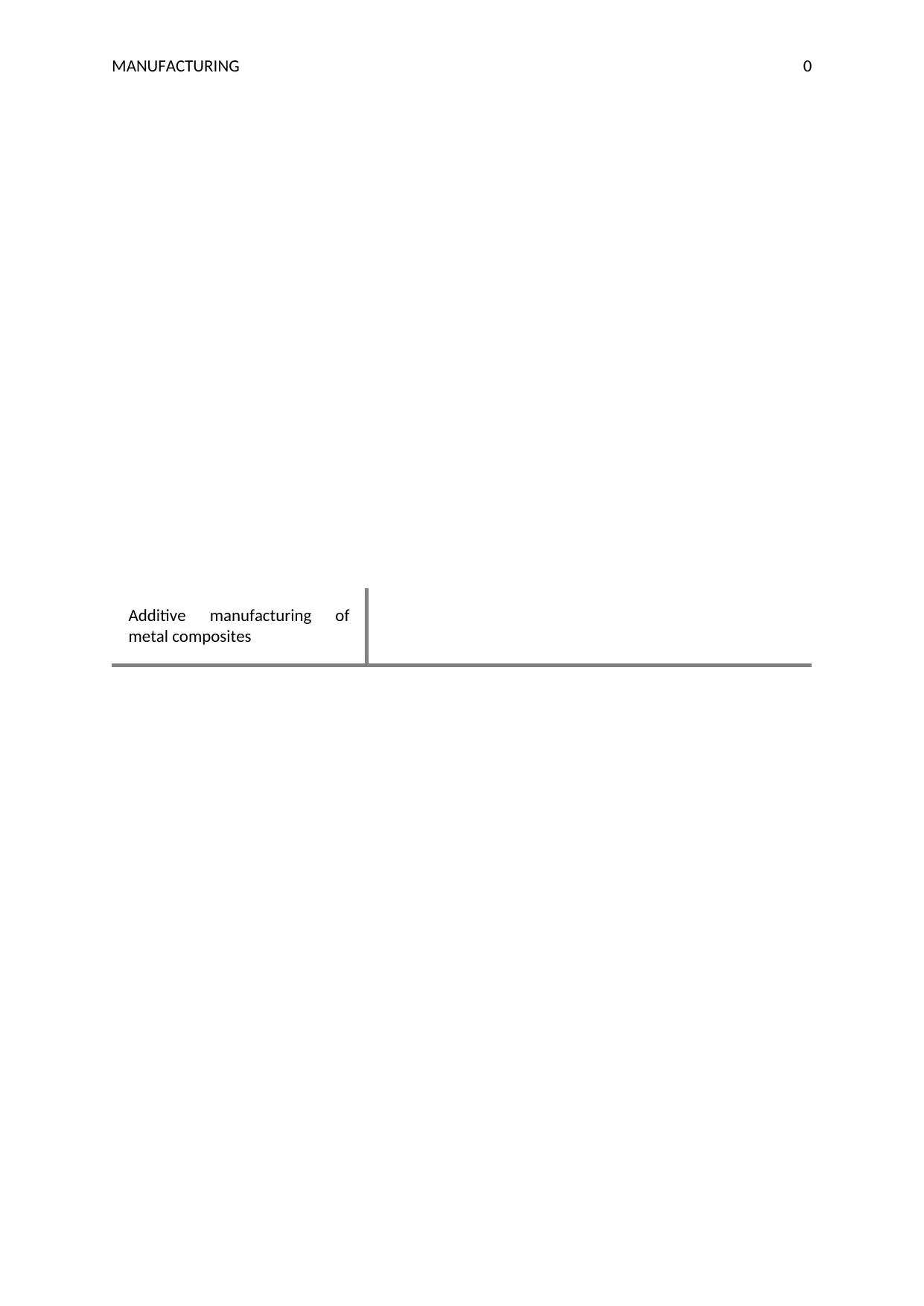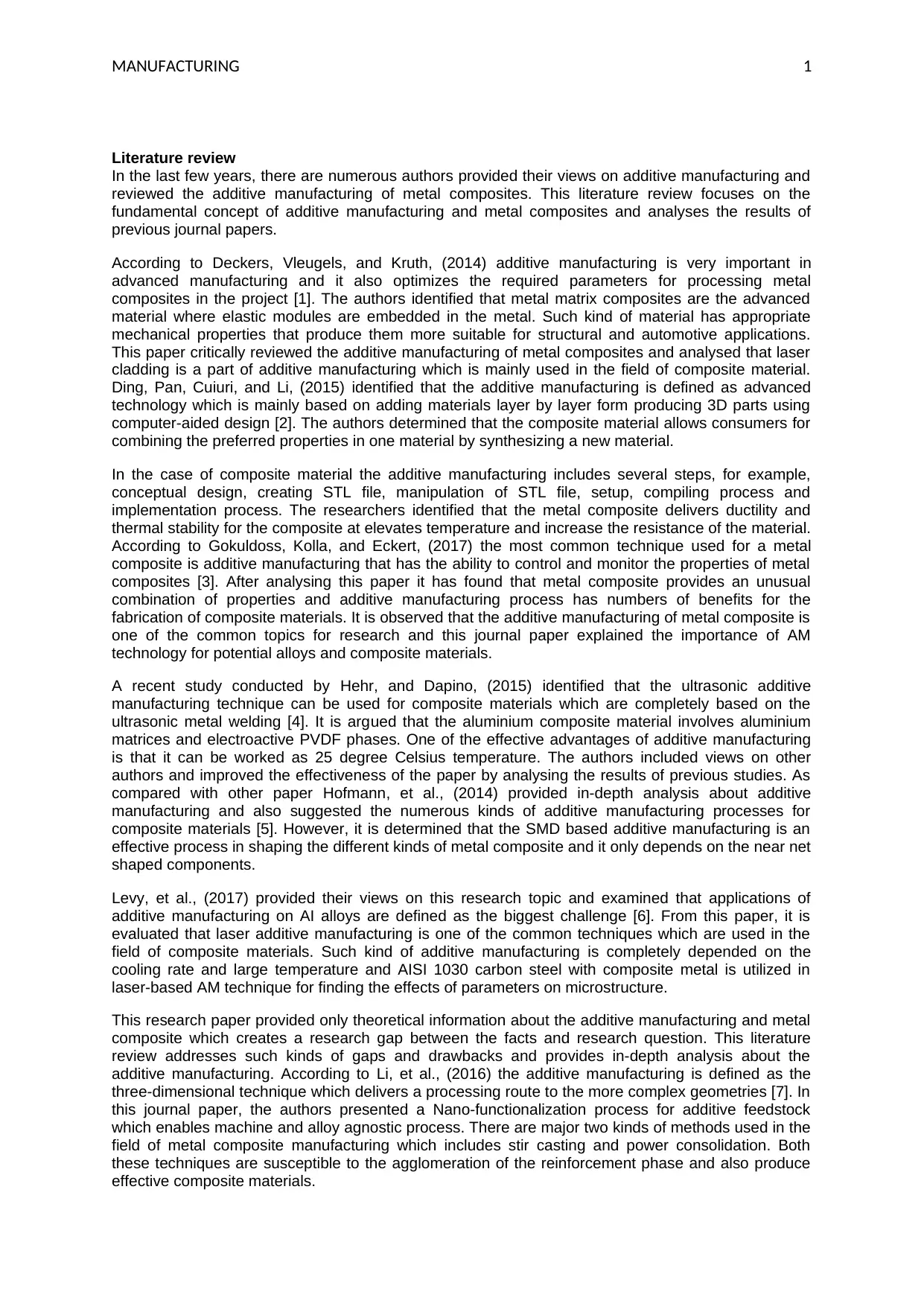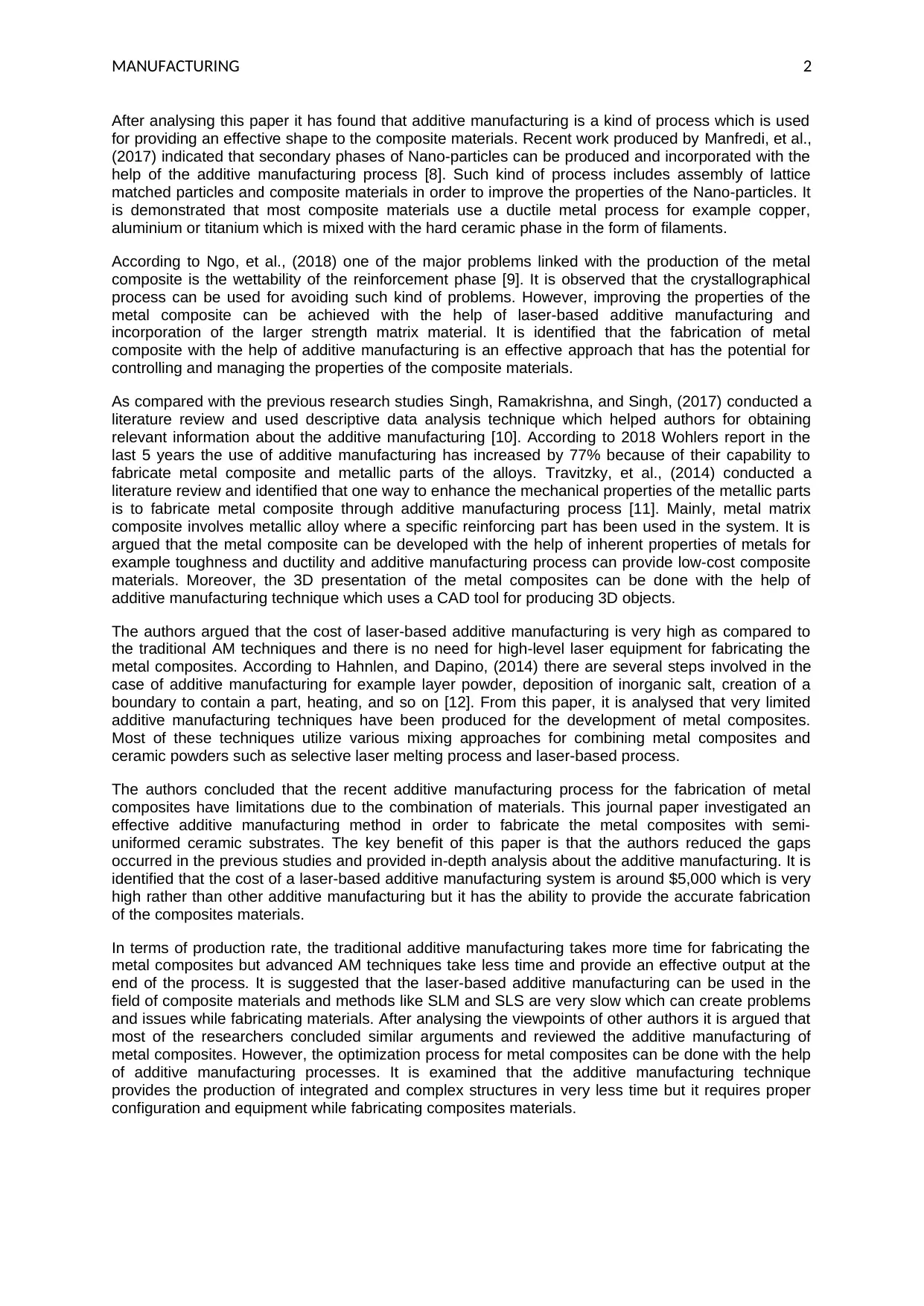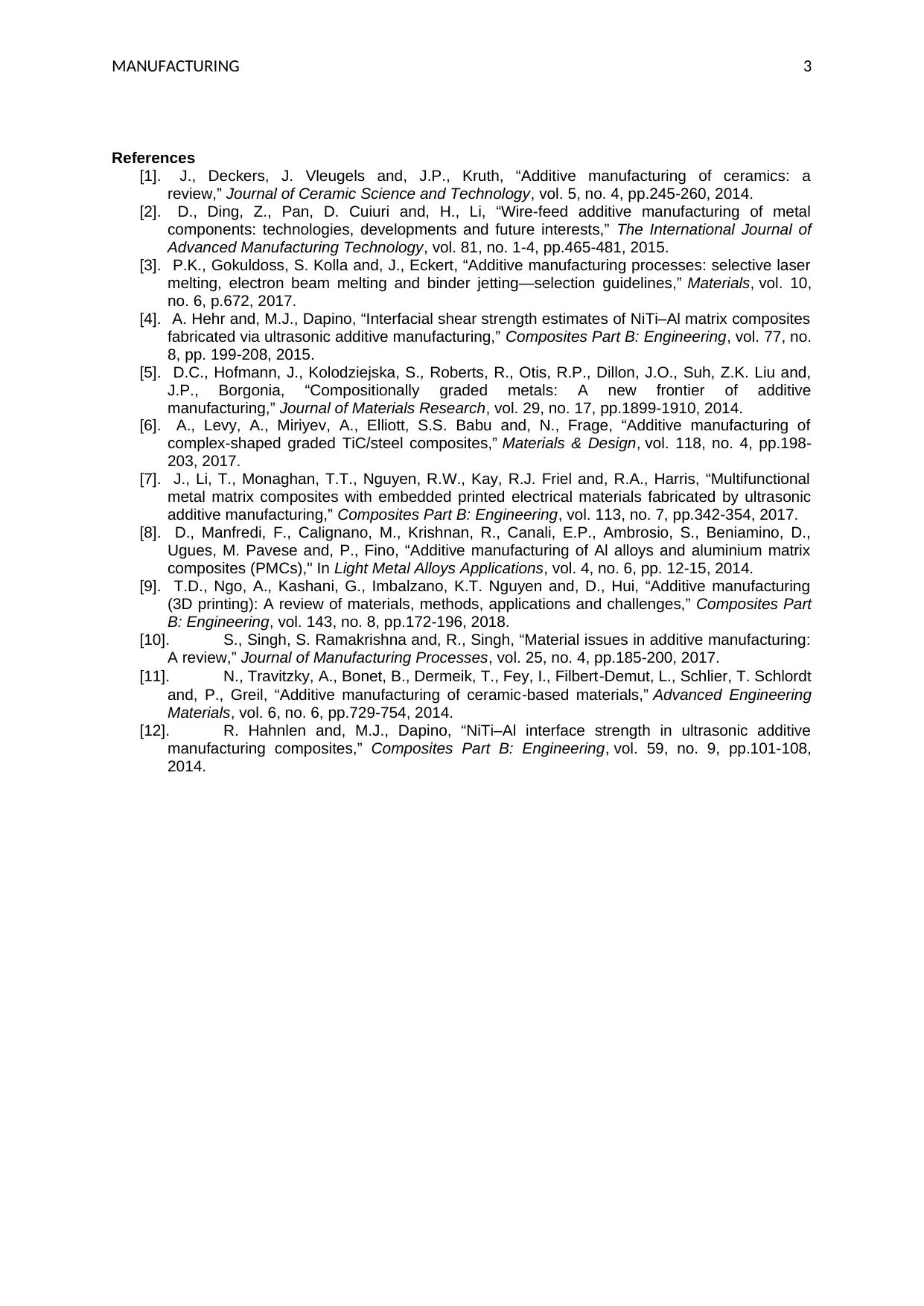Review of Additive Manufacturing Techniques for Metal Composites
VerifiedAdded on 2023/03/21
|4
|2302
|80
Literature Review
AI Summary
This literature review provides a comprehensive overview of additive manufacturing techniques for metal composites, drawing upon numerous authors' perspectives and research findings from recent years. It focuses on the fundamental concepts of additive manufacturing and metal composites, analyzing results from previous journal papers. The review covers various techniques, including laser cladding, ultrasonic additive manufacturing, and selective laser melting, highlighting their applications, advantages, and limitations in fabricating metal matrix composites. It also addresses challenges such as material wettability and cost considerations, while emphasizing the potential of additive manufacturing to control and manage the properties of composite materials. The review identifies research gaps and suggests future directions for optimizing metal composite fabrication through additive manufacturing processes, ultimately contributing to the advancement of materials science and engineering.

MANUFACTURING 0
Additive manufacturing of
metal composites
Additive manufacturing of
metal composites
Paraphrase This Document
Need a fresh take? Get an instant paraphrase of this document with our AI Paraphraser

MANUFACTURING 1
Literature review
In the last few years, there are numerous authors provided their views on additive manufacturing and
reviewed the additive manufacturing of metal composites. This literature review focuses on the
fundamental concept of additive manufacturing and metal composites and analyses the results of
previous journal papers.
According to Deckers, Vleugels, and Kruth, (2014) additive manufacturing is very important in
advanced manufacturing and it also optimizes the required parameters for processing metal
composites in the project [1]. The authors identified that metal matrix composites are the advanced
material where elastic modules are embedded in the metal. Such kind of material has appropriate
mechanical properties that produce them more suitable for structural and automotive applications.
This paper critically reviewed the additive manufacturing of metal composites and analysed that laser
cladding is a part of additive manufacturing which is mainly used in the field of composite material.
Ding, Pan, Cuiuri, and Li, (2015) identified that the additive manufacturing is defined as advanced
technology which is mainly based on adding materials layer by layer form producing 3D parts using
computer-aided design [2]. The authors determined that the composite material allows consumers for
combining the preferred properties in one material by synthesizing a new material.
In the case of composite material the additive manufacturing includes several steps, for example,
conceptual design, creating STL file, manipulation of STL file, setup, compiling process and
implementation process. The researchers identified that the metal composite delivers ductility and
thermal stability for the composite at elevates temperature and increase the resistance of the material.
According to Gokuldoss, Kolla, and Eckert, (2017) the most common technique used for a metal
composite is additive manufacturing that has the ability to control and monitor the properties of metal
composites [3]. After analysing this paper it has found that metal composite provides an unusual
combination of properties and additive manufacturing process has numbers of benefits for the
fabrication of composite materials. It is observed that the additive manufacturing of metal composite is
one of the common topics for research and this journal paper explained the importance of AM
technology for potential alloys and composite materials.
A recent study conducted by Hehr, and Dapino, (2015) identified that the ultrasonic additive
manufacturing technique can be used for composite materials which are completely based on the
ultrasonic metal welding [4]. It is argued that the aluminium composite material involves aluminium
matrices and electroactive PVDF phases. One of the effective advantages of additive manufacturing
is that it can be worked as 25 degree Celsius temperature. The authors included views on other
authors and improved the effectiveness of the paper by analysing the results of previous studies. As
compared with other paper Hofmann, et al., (2014) provided in-depth analysis about additive
manufacturing and also suggested the numerous kinds of additive manufacturing processes for
composite materials [5]. However, it is determined that the SMD based additive manufacturing is an
effective process in shaping the different kinds of metal composite and it only depends on the near net
shaped components.
Levy, et al., (2017) provided their views on this research topic and examined that applications of
additive manufacturing on AI alloys are defined as the biggest challenge [6]. From this paper, it is
evaluated that laser additive manufacturing is one of the common techniques which are used in the
field of composite materials. Such kind of additive manufacturing is completely depended on the
cooling rate and large temperature and AISI 1030 carbon steel with composite metal is utilized in
laser-based AM technique for finding the effects of parameters on microstructure.
This research paper provided only theoretical information about the additive manufacturing and metal
composite which creates a research gap between the facts and research question. This literature
review addresses such kinds of gaps and drawbacks and provides in-depth analysis about the
additive manufacturing. According to Li, et al., (2016) the additive manufacturing is defined as the
three-dimensional technique which delivers a processing route to the more complex geometries [7]. In
this journal paper, the authors presented a Nano-functionalization process for additive feedstock
which enables machine and alloy agnostic process. There are major two kinds of methods used in the
field of metal composite manufacturing which includes stir casting and power consolidation. Both
these techniques are susceptible to the agglomeration of the reinforcement phase and also produce
effective composite materials.
Literature review
In the last few years, there are numerous authors provided their views on additive manufacturing and
reviewed the additive manufacturing of metal composites. This literature review focuses on the
fundamental concept of additive manufacturing and metal composites and analyses the results of
previous journal papers.
According to Deckers, Vleugels, and Kruth, (2014) additive manufacturing is very important in
advanced manufacturing and it also optimizes the required parameters for processing metal
composites in the project [1]. The authors identified that metal matrix composites are the advanced
material where elastic modules are embedded in the metal. Such kind of material has appropriate
mechanical properties that produce them more suitable for structural and automotive applications.
This paper critically reviewed the additive manufacturing of metal composites and analysed that laser
cladding is a part of additive manufacturing which is mainly used in the field of composite material.
Ding, Pan, Cuiuri, and Li, (2015) identified that the additive manufacturing is defined as advanced
technology which is mainly based on adding materials layer by layer form producing 3D parts using
computer-aided design [2]. The authors determined that the composite material allows consumers for
combining the preferred properties in one material by synthesizing a new material.
In the case of composite material the additive manufacturing includes several steps, for example,
conceptual design, creating STL file, manipulation of STL file, setup, compiling process and
implementation process. The researchers identified that the metal composite delivers ductility and
thermal stability for the composite at elevates temperature and increase the resistance of the material.
According to Gokuldoss, Kolla, and Eckert, (2017) the most common technique used for a metal
composite is additive manufacturing that has the ability to control and monitor the properties of metal
composites [3]. After analysing this paper it has found that metal composite provides an unusual
combination of properties and additive manufacturing process has numbers of benefits for the
fabrication of composite materials. It is observed that the additive manufacturing of metal composite is
one of the common topics for research and this journal paper explained the importance of AM
technology for potential alloys and composite materials.
A recent study conducted by Hehr, and Dapino, (2015) identified that the ultrasonic additive
manufacturing technique can be used for composite materials which are completely based on the
ultrasonic metal welding [4]. It is argued that the aluminium composite material involves aluminium
matrices and electroactive PVDF phases. One of the effective advantages of additive manufacturing
is that it can be worked as 25 degree Celsius temperature. The authors included views on other
authors and improved the effectiveness of the paper by analysing the results of previous studies. As
compared with other paper Hofmann, et al., (2014) provided in-depth analysis about additive
manufacturing and also suggested the numerous kinds of additive manufacturing processes for
composite materials [5]. However, it is determined that the SMD based additive manufacturing is an
effective process in shaping the different kinds of metal composite and it only depends on the near net
shaped components.
Levy, et al., (2017) provided their views on this research topic and examined that applications of
additive manufacturing on AI alloys are defined as the biggest challenge [6]. From this paper, it is
evaluated that laser additive manufacturing is one of the common techniques which are used in the
field of composite materials. Such kind of additive manufacturing is completely depended on the
cooling rate and large temperature and AISI 1030 carbon steel with composite metal is utilized in
laser-based AM technique for finding the effects of parameters on microstructure.
This research paper provided only theoretical information about the additive manufacturing and metal
composite which creates a research gap between the facts and research question. This literature
review addresses such kinds of gaps and drawbacks and provides in-depth analysis about the
additive manufacturing. According to Li, et al., (2016) the additive manufacturing is defined as the
three-dimensional technique which delivers a processing route to the more complex geometries [7]. In
this journal paper, the authors presented a Nano-functionalization process for additive feedstock
which enables machine and alloy agnostic process. There are major two kinds of methods used in the
field of metal composite manufacturing which includes stir casting and power consolidation. Both
these techniques are susceptible to the agglomeration of the reinforcement phase and also produce
effective composite materials.

MANUFACTURING 2
After analysing this paper it has found that additive manufacturing is a kind of process which is used
for providing an effective shape to the composite materials. Recent work produced by Manfredi, et al.,
(2017) indicated that secondary phases of Nano-particles can be produced and incorporated with the
help of the additive manufacturing process [8]. Such kind of process includes assembly of lattice
matched particles and composite materials in order to improve the properties of the Nano-particles. It
is demonstrated that most composite materials use a ductile metal process for example copper,
aluminium or titanium which is mixed with the hard ceramic phase in the form of filaments.
According to Ngo, et al., (2018) one of the major problems linked with the production of the metal
composite is the wettability of the reinforcement phase [9]. It is observed that the crystallographical
process can be used for avoiding such kind of problems. However, improving the properties of the
metal composite can be achieved with the help of laser-based additive manufacturing and
incorporation of the larger strength matrix material. It is identified that the fabrication of metal
composite with the help of additive manufacturing is an effective approach that has the potential for
controlling and managing the properties of the composite materials.
As compared with the previous research studies Singh, Ramakrishna, and Singh, (2017) conducted a
literature review and used descriptive data analysis technique which helped authors for obtaining
relevant information about the additive manufacturing [10]. According to 2018 Wohlers report in the
last 5 years the use of additive manufacturing has increased by 77% because of their capability to
fabricate metal composite and metallic parts of the alloys. Travitzky, et al., (2014) conducted a
literature review and identified that one way to enhance the mechanical properties of the metallic parts
is to fabricate metal composite through additive manufacturing process [11]. Mainly, metal matrix
composite involves metallic alloy where a specific reinforcing part has been used in the system. It is
argued that the metal composite can be developed with the help of inherent properties of metals for
example toughness and ductility and additive manufacturing process can provide low-cost composite
materials. Moreover, the 3D presentation of the metal composites can be done with the help of
additive manufacturing technique which uses a CAD tool for producing 3D objects.
The authors argued that the cost of laser-based additive manufacturing is very high as compared to
the traditional AM techniques and there is no need for high-level laser equipment for fabricating the
metal composites. According to Hahnlen, and Dapino, (2014) there are several steps involved in the
case of additive manufacturing for example layer powder, deposition of inorganic salt, creation of a
boundary to contain a part, heating, and so on [12]. From this paper, it is analysed that very limited
additive manufacturing techniques have been produced for the development of metal composites.
Most of these techniques utilize various mixing approaches for combining metal composites and
ceramic powders such as selective laser melting process and laser-based process.
The authors concluded that the recent additive manufacturing process for the fabrication of metal
composites have limitations due to the combination of materials. This journal paper investigated an
effective additive manufacturing method in order to fabricate the metal composites with semi-
uniformed ceramic substrates. The key benefit of this paper is that the authors reduced the gaps
occurred in the previous studies and provided in-depth analysis about the additive manufacturing. It is
identified that the cost of a laser-based additive manufacturing system is around $5,000 which is very
high rather than other additive manufacturing but it has the ability to provide the accurate fabrication
of the composites materials.
In terms of production rate, the traditional additive manufacturing takes more time for fabricating the
metal composites but advanced AM techniques take less time and provide an effective output at the
end of the process. It is suggested that the laser-based additive manufacturing can be used in the
field of composite materials and methods like SLM and SLS are very slow which can create problems
and issues while fabricating materials. After analysing the viewpoints of other authors it is argued that
most of the researchers concluded similar arguments and reviewed the additive manufacturing of
metal composites. However, the optimization process for metal composites can be done with the help
of additive manufacturing processes. It is examined that the additive manufacturing technique
provides the production of integrated and complex structures in very less time but it requires proper
configuration and equipment while fabricating composites materials.
After analysing this paper it has found that additive manufacturing is a kind of process which is used
for providing an effective shape to the composite materials. Recent work produced by Manfredi, et al.,
(2017) indicated that secondary phases of Nano-particles can be produced and incorporated with the
help of the additive manufacturing process [8]. Such kind of process includes assembly of lattice
matched particles and composite materials in order to improve the properties of the Nano-particles. It
is demonstrated that most composite materials use a ductile metal process for example copper,
aluminium or titanium which is mixed with the hard ceramic phase in the form of filaments.
According to Ngo, et al., (2018) one of the major problems linked with the production of the metal
composite is the wettability of the reinforcement phase [9]. It is observed that the crystallographical
process can be used for avoiding such kind of problems. However, improving the properties of the
metal composite can be achieved with the help of laser-based additive manufacturing and
incorporation of the larger strength matrix material. It is identified that the fabrication of metal
composite with the help of additive manufacturing is an effective approach that has the potential for
controlling and managing the properties of the composite materials.
As compared with the previous research studies Singh, Ramakrishna, and Singh, (2017) conducted a
literature review and used descriptive data analysis technique which helped authors for obtaining
relevant information about the additive manufacturing [10]. According to 2018 Wohlers report in the
last 5 years the use of additive manufacturing has increased by 77% because of their capability to
fabricate metal composite and metallic parts of the alloys. Travitzky, et al., (2014) conducted a
literature review and identified that one way to enhance the mechanical properties of the metallic parts
is to fabricate metal composite through additive manufacturing process [11]. Mainly, metal matrix
composite involves metallic alloy where a specific reinforcing part has been used in the system. It is
argued that the metal composite can be developed with the help of inherent properties of metals for
example toughness and ductility and additive manufacturing process can provide low-cost composite
materials. Moreover, the 3D presentation of the metal composites can be done with the help of
additive manufacturing technique which uses a CAD tool for producing 3D objects.
The authors argued that the cost of laser-based additive manufacturing is very high as compared to
the traditional AM techniques and there is no need for high-level laser equipment for fabricating the
metal composites. According to Hahnlen, and Dapino, (2014) there are several steps involved in the
case of additive manufacturing for example layer powder, deposition of inorganic salt, creation of a
boundary to contain a part, heating, and so on [12]. From this paper, it is analysed that very limited
additive manufacturing techniques have been produced for the development of metal composites.
Most of these techniques utilize various mixing approaches for combining metal composites and
ceramic powders such as selective laser melting process and laser-based process.
The authors concluded that the recent additive manufacturing process for the fabrication of metal
composites have limitations due to the combination of materials. This journal paper investigated an
effective additive manufacturing method in order to fabricate the metal composites with semi-
uniformed ceramic substrates. The key benefit of this paper is that the authors reduced the gaps
occurred in the previous studies and provided in-depth analysis about the additive manufacturing. It is
identified that the cost of a laser-based additive manufacturing system is around $5,000 which is very
high rather than other additive manufacturing but it has the ability to provide the accurate fabrication
of the composites materials.
In terms of production rate, the traditional additive manufacturing takes more time for fabricating the
metal composites but advanced AM techniques take less time and provide an effective output at the
end of the process. It is suggested that the laser-based additive manufacturing can be used in the
field of composite materials and methods like SLM and SLS are very slow which can create problems
and issues while fabricating materials. After analysing the viewpoints of other authors it is argued that
most of the researchers concluded similar arguments and reviewed the additive manufacturing of
metal composites. However, the optimization process for metal composites can be done with the help
of additive manufacturing processes. It is examined that the additive manufacturing technique
provides the production of integrated and complex structures in very less time but it requires proper
configuration and equipment while fabricating composites materials.
⊘ This is a preview!⊘
Do you want full access?
Subscribe today to unlock all pages.

Trusted by 1+ million students worldwide

MANUFACTURING 3
References
[1]. J., Deckers, J. Vleugels and, J.P., Kruth, “Additive manufacturing of ceramics: a
review,” Journal of Ceramic Science and Technology, vol. 5, no. 4, pp.245-260, 2014.
[2]. D., Ding, Z., Pan, D. Cuiuri and, H., Li, “Wire-feed additive manufacturing of metal
components: technologies, developments and future interests,” The International Journal of
Advanced Manufacturing Technology, vol. 81, no. 1-4, pp.465-481, 2015.
[3]. P.K., Gokuldoss, S. Kolla and, J., Eckert, “Additive manufacturing processes: selective laser
melting, electron beam melting and binder jetting—selection guidelines,” Materials, vol. 10,
no. 6, p.672, 2017.
[4]. A. Hehr and, M.J., Dapino, “Interfacial shear strength estimates of NiTi–Al matrix composites
fabricated via ultrasonic additive manufacturing,” Composites Part B: Engineering, vol. 77, no.
8, pp. 199-208, 2015.
[5]. D.C., Hofmann, J., Kolodziejska, S., Roberts, R., Otis, R.P., Dillon, J.O., Suh, Z.K. Liu and,
J.P., Borgonia, “Compositionally graded metals: A new frontier of additive
manufacturing,” Journal of Materials Research, vol. 29, no. 17, pp.1899-1910, 2014.
[6]. A., Levy, A., Miriyev, A., Elliott, S.S. Babu and, N., Frage, “Additive manufacturing of
complex-shaped graded TiC/steel composites,” Materials & Design, vol. 118, no. 4, pp.198-
203, 2017.
[7]. J., Li, T., Monaghan, T.T., Nguyen, R.W., Kay, R.J. Friel and, R.A., Harris, “Multifunctional
metal matrix composites with embedded printed electrical materials fabricated by ultrasonic
additive manufacturing,” Composites Part B: Engineering, vol. 113, no. 7, pp.342-354, 2017.
[8]. D., Manfredi, F., Calignano, M., Krishnan, R., Canali, E.P., Ambrosio, S., Beniamino, D.,
Ugues, M. Pavese and, P., Fino, “Additive manufacturing of Al alloys and aluminium matrix
composites (PMCs)," In Light Metal Alloys Applications, vol. 4, no. 6, pp. 12-15, 2014.
[9]. T.D., Ngo, A., Kashani, G., Imbalzano, K.T. Nguyen and, D., Hui, “Additive manufacturing
(3D printing): A review of materials, methods, applications and challenges,” Composites Part
B: Engineering, vol. 143, no. 8, pp.172-196, 2018.
[10]. S., Singh, S. Ramakrishna and, R., Singh, “Material issues in additive manufacturing:
A review,” Journal of Manufacturing Processes, vol. 25, no. 4, pp.185-200, 2017.
[11]. N., Travitzky, A., Bonet, B., Dermeik, T., Fey, I., Filbert‐Demut, L., Schlier, T. Schlordt
and, P., Greil, “Additive manufacturing of ceramic‐based materials,” Advanced Engineering
Materials, vol. 6, no. 6, pp.729-754, 2014.
[12]. R. Hahnlen and, M.J., Dapino, “NiTi–Al interface strength in ultrasonic additive
manufacturing composites,” Composites Part B: Engineering, vol. 59, no. 9, pp.101-108,
2014.
References
[1]. J., Deckers, J. Vleugels and, J.P., Kruth, “Additive manufacturing of ceramics: a
review,” Journal of Ceramic Science and Technology, vol. 5, no. 4, pp.245-260, 2014.
[2]. D., Ding, Z., Pan, D. Cuiuri and, H., Li, “Wire-feed additive manufacturing of metal
components: technologies, developments and future interests,” The International Journal of
Advanced Manufacturing Technology, vol. 81, no. 1-4, pp.465-481, 2015.
[3]. P.K., Gokuldoss, S. Kolla and, J., Eckert, “Additive manufacturing processes: selective laser
melting, electron beam melting and binder jetting—selection guidelines,” Materials, vol. 10,
no. 6, p.672, 2017.
[4]. A. Hehr and, M.J., Dapino, “Interfacial shear strength estimates of NiTi–Al matrix composites
fabricated via ultrasonic additive manufacturing,” Composites Part B: Engineering, vol. 77, no.
8, pp. 199-208, 2015.
[5]. D.C., Hofmann, J., Kolodziejska, S., Roberts, R., Otis, R.P., Dillon, J.O., Suh, Z.K. Liu and,
J.P., Borgonia, “Compositionally graded metals: A new frontier of additive
manufacturing,” Journal of Materials Research, vol. 29, no. 17, pp.1899-1910, 2014.
[6]. A., Levy, A., Miriyev, A., Elliott, S.S. Babu and, N., Frage, “Additive manufacturing of
complex-shaped graded TiC/steel composites,” Materials & Design, vol. 118, no. 4, pp.198-
203, 2017.
[7]. J., Li, T., Monaghan, T.T., Nguyen, R.W., Kay, R.J. Friel and, R.A., Harris, “Multifunctional
metal matrix composites with embedded printed electrical materials fabricated by ultrasonic
additive manufacturing,” Composites Part B: Engineering, vol. 113, no. 7, pp.342-354, 2017.
[8]. D., Manfredi, F., Calignano, M., Krishnan, R., Canali, E.P., Ambrosio, S., Beniamino, D.,
Ugues, M. Pavese and, P., Fino, “Additive manufacturing of Al alloys and aluminium matrix
composites (PMCs)," In Light Metal Alloys Applications, vol. 4, no. 6, pp. 12-15, 2014.
[9]. T.D., Ngo, A., Kashani, G., Imbalzano, K.T. Nguyen and, D., Hui, “Additive manufacturing
(3D printing): A review of materials, methods, applications and challenges,” Composites Part
B: Engineering, vol. 143, no. 8, pp.172-196, 2018.
[10]. S., Singh, S. Ramakrishna and, R., Singh, “Material issues in additive manufacturing:
A review,” Journal of Manufacturing Processes, vol. 25, no. 4, pp.185-200, 2017.
[11]. N., Travitzky, A., Bonet, B., Dermeik, T., Fey, I., Filbert‐Demut, L., Schlier, T. Schlordt
and, P., Greil, “Additive manufacturing of ceramic‐based materials,” Advanced Engineering
Materials, vol. 6, no. 6, pp.729-754, 2014.
[12]. R. Hahnlen and, M.J., Dapino, “NiTi–Al interface strength in ultrasonic additive
manufacturing composites,” Composites Part B: Engineering, vol. 59, no. 9, pp.101-108,
2014.
1 out of 4
Related Documents
Your All-in-One AI-Powered Toolkit for Academic Success.
+13062052269
info@desklib.com
Available 24*7 on WhatsApp / Email
![[object Object]](/_next/static/media/star-bottom.7253800d.svg)
Unlock your academic potential
Copyright © 2020–2025 A2Z Services. All Rights Reserved. Developed and managed by ZUCOL.





